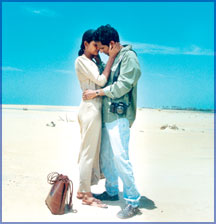
Dr Abeyratne is an international civil servant working in the United Nations system. More details of the author can be found in his website at www.abyratne.com
Film: Ira Mediyama (August Sun)
Director: Prasanna Vithanage
Main Actors: Nimmi Harasgama, Peter D'Almeida, Namal Jayasinghe
On 6 September 2003, the film Ira Mediyama (August Sun) was shown to a packed house at the Parisien Cinema, Montreal. The movie is about three categories of persons affected by the civil war in Sri Lanka: the uprooted and displaced Muslims and Tamils from the war-torn north; the soldiers who go to war and their families; and the ones who lose someone near and dear for the war. The film is therefore about what we have now learnt to call "collateral damage" of war and its destructive effects .
 |
|---|
Not surprisingly, Ira Mediyama was a contestant at the 2003 Montreal World Film Festival Competition finals. As I left the cinema, I was struck by the inevitable continuum of the film where it ends with the three protagonists, portraying archetypes of real life characters and representing three categories most affected by the war, being shown at the same location. This was a most forceful and vibrant ending, which left behind a sense of foreboding and a certain enduring intimacy between the characters in their common struggle for survival. The film was redolent of indomitability of character and imagery, through cricket commentaries that can be heard in the background with monotonous regularity amidst such powerful imagery as that of a Muslim man, uprooted from his home, dismantling a wall clock to be taken away, to another time, another place. Through the image of cricket, the film conveys the inarticulate premise that war should be fought on a level playing field but at the same time must not be considered a game, where lost lives are counted in the same manner as runs collected or wickets fallen.
 |
|---|
Through sinuously subtle cinematic nuances throughout, the film mesmerizes the audience with the Kafkaesque message that there is only a spiritual world; and that what we call the physical world is the evil in the spiritual one. The chanting of Buddhist pirith chants, the melodious intonations of the Islamic faith and the calming presence of the Christian church are all images that the Director uses in telling us that there is nothing but a spiritual world and this deprives us of hope and gives us certainty. Ira Mediyama brings to bear the realization that in the sphere of pure social reality, man lives as man neither as an abstract interiority nor as an isolated and unique social being. Through a contrived accumulation of single instances, the film makes us hope that should the world ever become a natural and simply experienced reality, as it once was our now divided reality of societal and natural abstraction would succumb to a new holistic reality that would achieve a homogeneity of a past period. The director blends the diversity of his characters through a profound intentionality that makes his point, which is that unlike in the game of cricket, where someone wins and someone loses, in war all are losers.
The musical score had the unobtrusive dignity that underscores serious themes in the cinema and succeeded in presenting a heterogeneous blend of eastern and western musical tradition. The piano was soothingly present and noticeable, and was presented solo as well as with the violin, carrying overtones of the musical genius of Marvin Hamlisch. The music added a certain tender dimension to the characters of Saman and Chamari, who remain within a platonic paradigm created for two adults alone in their world but who are trying to help one another through the crisis. Saman, who is coerced by Chamari to help her find her lost husband, eventually finds in Chamari an innocent diversion through the difficult trip they both make to the North. All the main characters in the movie are an invasion on our intellect and rush through the entire film without giving us time to move our eyes away from the screen. It was as though the director had us by the hand and moved us through the North Central Province of Sri Lanka, making us see what he saw, never letting go for a moment for fear of our missing the entirety of his message. The vehemence and aspiration of the message was compelling, and the intense awareness of the vibrancy of a people who have borne immense difficulty was quite invasive. However, theories, which are dangerous things, are absent from the film, as is the obvious depiction of death and violence. Apart from one grotesque scene showing a badly wounded woman emerging from a mud hut demolished by aerial bombing, the viewer is spared of being shocked off his seat.
The film had not neglected to reflect the importance of the child in the equation of war. The little boy who asks questions about his school when he and his father are driven out of their home, and the loss of his only companion, his dog, heighten the pathos.
Finally, the main thrust of the message, I thought, was that the war in Sri Lanka is not a typical war fought by sworn enemies, but rather by sons of an unhappy country who had misunderstood each other's aspirations for generations until the only way out was to take up arms against each other. In such a situation, the truly unfortunate are those who are left behind to clean up the mess and get on with their lives.